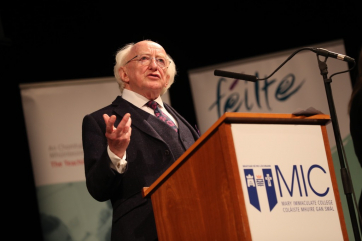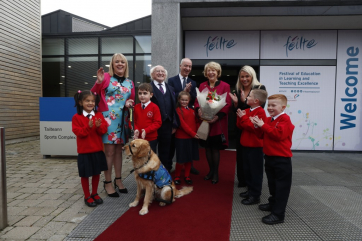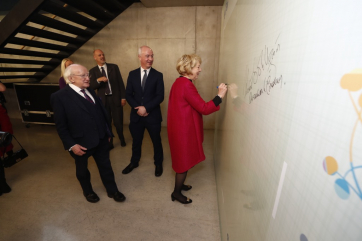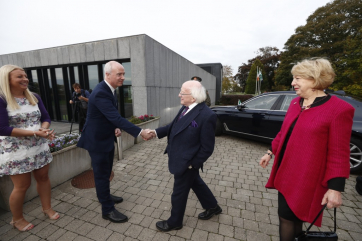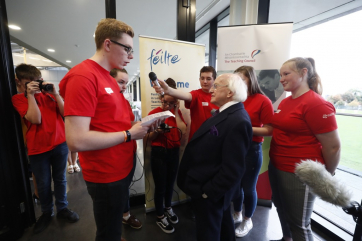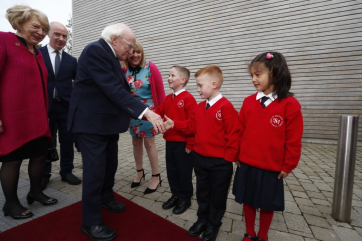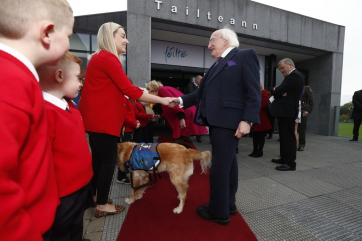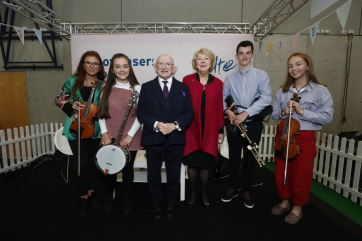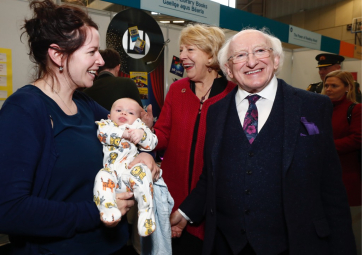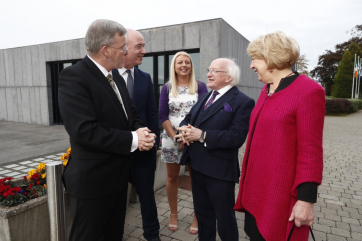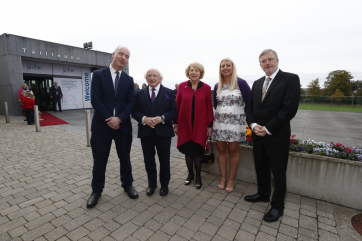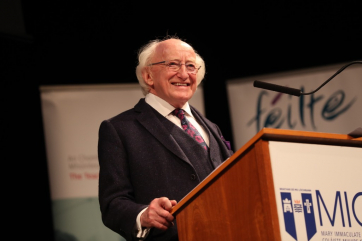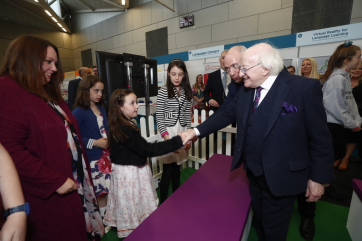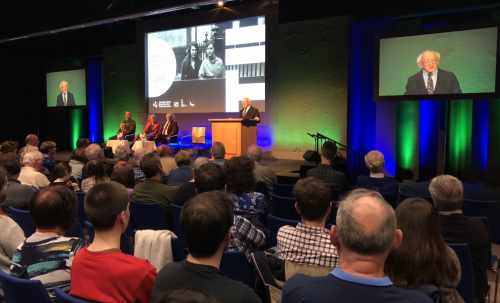Speech at the Civil Rights Festival, Derry City
The Guildhall, Derry City, Saturday, 6th October 2018
A Mhéara,
A Chomhairleoirí,
A dhaoine uaisle,
A cháirde,
May I begin by expressing my gratitude to the 50th Anniversary Civil Rights Commemoration Committee for their very generous invitation to attend and address this festival today. As President of Ireland, it is a great honour to join you all in commemorating one of the great movements for justice and civic equality on our island, the Northern Ireland Civil Rights Movement, on this, the fiftieth anniversary of one of the most important events in the history of our island in the 20th century, the Civil Rights march that took place in this great city on the 5th of October, 1968.
Over the past seven years, I have had the opportunity to speak at commemorations marking the centenaries of some of the formative events of the preceding century. It has been a pleasure to hear the stories and experiences of individuals, communities and movements as they recalled and interpreted these events; became involved in the construction or revision of collective memory.
The social and economic forces with which communities contended and which they sought to shape received a diversity of interpretations. Across this island, these commemorations have facilitated, if not a wholesale re-evaluation of the past, a re-engagement with our collective history. The role of economic forces, of exclusions, got a weak emphasis, and thus the possibility of recognising those upon whom – to quote Edward Thompson – the ‘enormous condescension of history’ had fallen-: women, workers, rural labourers, did not get sufficient space in the narrative.
Some of the moments recalled were of course foundational for the political traditions on our island, whether nationalist, unionist, socialist, or feminist: the Solemn League and Covenant, the 1913 Lockout, the 1916 Rising, the struggle for women’s suffrage. Others were experienced in common by all who lived on our island at that time, such as the First World War, which was for those who lived in the southern state, perhaps, too long suppressed in the popular mind and the public memory. The recollection of that terrible conflagration, that clash of empires, made tangible to new generations the horror and savagery that had befallen a previous generation of Irish men and Irish women, North and South, East and West.
Yet, we retain but few living connections to those events. The last surviving veteran of the War of Independence, Dan Keating, died eleven years ago. Florence Green, last living veteran of the First World War, passed away in 2012.
As much as the events of one hundred years ago can still evoke profound emotions, the events which we have gathered here this weekend to remember retain so much more of their immediacy and potency, falling as they do within the living memory of so many of the people of Derry, of Northern Ireland and this island, both as witnesses to and agents of history. The depravation of basic civil rights and the economic inequalities which the Civil Rights Movement sought to end are thus not only in the realm of ‘public’ or ‘collective’ memory – difficult and sometimes amorphous as that concept may be – but they constitute a living memory of an experience endured by so many.
The historical origin of those civic inequalities can be found at the moment of the establishment of the two states on our island. Though all will not agree with the totality of his analysis, there is a truth to James Connolly’s famous prophesy that a partitioned Ireland would witness a ‘carnival of reaction’ across the island. And indeed it did.
We are, only now, in our own times, beginning to confront some residual elements the full reality of the authoritarian and carceral nature of the Free State and its successor. Elevating the rights of property and those who held property as it did, even as it diminished women and working-class people. It was for those an exclusionary state. The legislative record of the Oireachtas of the 1920s and 1930s reveals the degree to which rights, so long, in the case of an inclusive republicanism, fought for, and so intrinsic to the character of many of the earlier movements that propelled the Irish Revolution, were removed and restricted: the introduction of censorship, the abolition of legal divorce, the prohibition of women sitting on juries, the public service marriage bar, the ban on contraceptives, and the wholesale exclusion from women from designated occupations and professions.
In its foundational moments, the state in Northern Ireland created its own legislative and institutional inequalities through the gerrymandering of electoral districts, exclusions from government employment, the abuse of the Special Powers Act, and frequent exhortations to exclude members of the Catholic and Nationalist communities from private companies.
The Northern Ireland state sustained and deepened those inequalities through the long, difficult years of the Great Depression – indeed, it was in 1934, in the midst of a debate in Stormont, that Sir James Craig uttered the now fateful phrase ‘we are a Protestant Parliament and a Protestant State’, an explicit counterpart, at least in Craig’s mind, to what he viewed as the ‘Catholic’ state in the South. Despite the friendships and conviviality between Protestant and Catholic and between Unionist and Nationalist neighbours, the structural features of the state were, in key legislative areas, sectarian.
Of course, it is important to recognise that neither Catholic and Nationalist, nor Protestant and Unionist communities, were or are monolithic. The history of our island has too often been retold as one of a simple tribalism, reducing all diverse examples of co-operation and conflict between classes, genders, and peoples to a simple binary. The anti-intellectualism that flowed from this facilitated a hostility to a politics based on economic issues, and certainly opposed notions of class conflict.
I must admit that this kind of simplistic narrative of binary tribalism has sometimes been found in political expression in the South or in Britain when speeches are made of Northern Ireland. This not only omits and ignores historic and contemporary responsibilities but can, by ignoring the potential, in any pluralist sense, for political change and political progress, foreclose the immense possibilities for the future, creating a justified sense of abandonment in Northern Ireland, and an atmosphere of political solipsism elsewhere.
As Lord Bew and Professor Patterson have demonstrated in their own scholarly work, the intensification of sectarianism in the 1930s was not the result only communal divisions, but partly the consequence of political calculation on the part of the leaders of unionism, who feared that the cross-class coalition, so carefully assembled to oppose Home Rule in the early 1900s, would fall asunder amidst the economic dislocation of the 1930s.
When Basil Brooke began what would be a very long political career as an MP for his native Fermanagh he feared that his farming constituents would seek to form their own political movement to oppose the payment of land annuities. If it had commenced, that campaign would, at source, have had a most unusual genealogy – it was Éamon de Valera’s promise to end land annuities, itself borrowed from the republican socialist Peadar O'Donnell, that had propelled Fianna Fáil to electoral victory in the general election of 1932.
Those connections tell us something of the complexity of the politics of class, religion and nation on our island. Yet for all such unusual cross-fertilisation of ideas – a product of hundreds of years of shared institutions - the relationship between the two states, despite the initial promise of the Collins-Craig pact, remained, from the 1920s to the 1960s, one of mutual, often simmering, suspicion. The enactment of Articles 2 and 3 of the Constitution of 1937, though recognised as aspirational by its drafters, nonetheless claimed and envisioned the exercise of sovereignty over the whole island. In codifying a provision which so ignored what we now recognise as the principle of consent, Articles 2 and 3 were immediately seen by the unionist community as a threat, one that could be, and was frequently, invoked.
The formation of the United Nations opened up the potential for a new politics of hope and co-operation, not only amidst the ruins of Europe but across our world. The preamble of the United Nations charter sought to capture the aspirations of the peoples of the world: ‘We the Peoples of the United Nations determined to save succeeding generations from the scourge of war…and to promote social progress and better standards of life in larger freedom’. That larger freedom, and the rights necessary to secure that freedom – not just civil rights but economic and social rights, rights in all their fullness – were given legal form – if not juridical form - in the Universal Declaration of Human Rights in 1948, which still stands as one of the great moral achievements of the post-war world.
The great question was whether those rights would be vindicated by states throughout the world, whether through regional treaties, such as the less radical European Convention on Human Rights with its associated Court, or by member states directly. In Britain, a Labour Government sought to pursue what the socialist Harold Laski termed a ‘revolution by consent’, by banishing what the liberal William Beveridge had called the ‘five giants’ of want, disease, ignorance, squalor and idleness. The building of this ‘New Jerusalem’ found its own echoes in the French Fourth Republic and the Federal Republic of Germany.
The ‘Keynesian welfare state’, committed to full employment – albeit on the model of the male breadwinner – and the collective provision of universal services had a transformative effect of the society of Northern Ireland. The National Health Service, one of the greatest accomplishments of the last century and one of the most practical examples of solidarity, was established in Northern Ireland, while the extension of free education enabled a remarkable generation of leaders and writers to proceed on to secondary education in this city – Ivan Cooper, John Hume, Bernadette McAliskey, Eamonn McCann, Seamus Deane, Seamus Heaney.
Let us recall that these transformative developments were not mirrored south of the border. The modest extension of free and universal healthcare to mothers and to children under 16 was denounced as ‘creeping socialism’ and stalled for five years, resisted by both the Catholic hierarchy, and more consequentially, the medical profession. That such opposition found a sympathetic ear amongst members of both communities here in Northern Ireland is a reminder, if any were needed, that the division on our island are not only a matter of constitutional politics, but of contending social and economic visions and particularly ideological views on the role of the state.
Yet the achievements of the welfare state in Northern Ireland in expanding the reach and scope of economic and social rights served to magnify the extent of the denial of other fundamental rights, no more so than in this city of Derry. The gerrymandering of electoral districts, the maintenance of the household franchise and of the business franchise in local authority elections – which let us never forget also of course affected working-class unionists - all conspired against the fundamental democratic principle of ‘one person, one vote’. The lack of adequate representation on local authorities - authorities which controlled planning and a certain proportion of housing provision - led to long waiting lists for homes and massive overcrowding.
This was most evident in what was then the South Ward of this city – in the 1960s, as many as 26 people were recorded as living in two rooms in a condemned house in Walker’s Square. This discrimination could also be seen in the imbalance in regional economic policy – unemployment was consistently higher here in Derry than in the North-East. Despite all the promise of the new regionalism of the Harold Wilson’s Government in London in 1964, and Terence O’Neill’s enthusiastic support of economic and social development, the locus of infrastructure development – whether in new housing, new industry, or in education – seemed to remain firmly outside Derry.
I recognise that is difficult for people who have lived their lives in the southern state to sufficiently understand the sense of helplessness experienced by the nationalist community in Northern Ireland in the pre and post-war years. The anti-partition initiatives of the southern state – which, let us recognise, simply ignored any principle of consent – served to provoke fear amongst the unionist community, creating an image of a threatening irredentist threat. That was a fear that seemed to be confirmed by the IRA Border Campaign of 1956-1962, which ended with the internment of hundreds of young men, North and South.
It was not an entirely barren time. In the Westminster Parliament, the small ‘Friends of Ireland’ group on the Labour backbenches sought to exert their influence in favour of civil rights, despite their thirteen years of opposition. The Northern Ireland Labour Party emerged as an advocate not only for the expansion of the welfare state and economic planning, but, from 1958, as a voice for human and civil rights in the Parliament of Northern Ireland. While the tentative rapprochement between the two states, symbolised by the two meetings between the Taoiseach Sean Lemass and Prime Minister of Northern Ireland Terence O’Neill, did not yield immediate results for people, North or South, it did indicate at least a softening of stances.
Those in Northern Ireland who sought to rectify injustice would look first to themselves for their inspiration and strength, and seek to draw from the other great movements for freedom and justice across the world. In May 1963, brave young women in Dungannon began a protest outside the offices of the Urban District Council demanding a fair allocation of housing. Their demands were not narrow, but universal, and their cry for justice echoed those uttered from the Carolinas to Florida.
One poster read, ‘Racial discrimination in Alabama hits Dungannon’. They were organised by the Homeless Citizens League established by two remarkable citizens, Conn and Patricia McCluskey. It was the McCluskeys who established the Campaign for Social Justice to catalogue and disseminate an accurate statistical portrait of the allocation of employment and housing, which revealed the deep-seated discrimination against Catholics. This is a most important lesson in a world that yields only slowly and painfully to change – to right an injustice, it must be first described, quantified, and brought to the attention of world opinion.
When Gerry Fitt was elected as the MP for West Belfast in 1966 he used his maiden speech to demand, in his words, ‘true democracy on these islands’. He found a sympathetic audience, for the Campaign for Social Justice and other groups had succeeded in securing the support of many Labour backbenchers, who now formed a ‘Campaign for Ulster Democracy’ group. They asked – and may I say the phrasing reflects the patient, perhaps even too-slow transition, from an imperial to a post-imperial mindset – how the British Government could allow the Government of Northern Ireland to, in their words, ‘operate a franchise system that no British government would consider for any independent Commonwealth state’.
The new Labour MPs of the 1966 intake were, in Harold Wilson’s words, a ‘new and irreverent generation challenging everything’, willing, finally, to hear the voices of the people of Northern Ireland. It is a reminder of the noble tradition of parliamentary agitation, and of the responsibility of those at the heart of power to declare their solidarity. Let us recall the force of Aneurin Bevan’s condemnation of the ‘squalid and trivial ends’ of the Suez Invasion.
Yet, however important the solidarity of backbenchers in Westminster may have been, it could be no substitute for participatory politics sourced in the people. That need was met by the formation of the Northern Ireland Civil Rights Association, whose leadership came from a diverse and broad cross-section of backgrounds: both Catholics and Protestants, nationalists, socialists, unionists, republicans, Northern Ireland Labour Party members, liberals, communists, and trade unionists.
Though diverse in their backgrounds, all were united in their determination to combat the deep inequalities which scarred Northern Ireland – inequalities in housing, voting, and policing - and their early campaigns focused not only on discrimination against the Catholic community, but also the Travelling community.
The Association demanded the principle of ‘one person, one vote’, an end to gerrymandering, elimination of discrimination in the allocation of government jobs and housing, the repeal of the Special Powers Act, and the disbandment of the Ulster Special Constabulary.
With all the distance in time, these demands now seem, not radical, but modest, constituting no more than, as one of the slogans of the day put it, ‘British Rights for British Citizens’.
In communities across Northern Ireland, people had already begun to take action. In early 1967, Austin Currie, as the MP for West Tyrone in the Northern Ireland Parliament, spoke of the ‘growing frustration and desperation’ as young homeless Catholic families were forced to squat; and of ‘more acts of civil disobedience, more emphasis on other means and less on traditional political means’. In June 1968, Austin Currie and a group of brave citizens occupied social housing in Caledon to protest the local authority’s discriminatory approach to allocating homes, one of the first major interventions of the Civil Rights Movement into the public consciousness.
On 24 August 1968, Currie and the Civil Rights Association organised a march between Coalisland and Dungannon on 24 August 1968 to protest the local authority’s discriminatory approach to the allocation of social housing. Hundreds of marchers proceeded to Dungannon, in an echo of the great marches undertaken by the Civil Rights Movement in the United States, only to be met by police barricades and counter-protesters. Despite the provocation, the Association insisted on, in the words of its chairperson Betty Sinclair, ‘showing the world that we are a peaceful people asking for our civil rights in an orderly manner.’
However, it would be the march of 5 October 1968 here in this city which brought the Civil Rights Movement to the attention of the world. It was, of course, undertaken at the request of the Derry Housing Action Committee, and may I say what an honour it is to see some of the members of the Committee here today. As Fionnbarra Ó Dochartaigh has reminded us, the origins of the Committee can be found in February 1968, following a discussion at Derry Corporation’s Housing Department between four women – ‘Mrs. McNamee, Dillon, Olphert, and Quigley’ - living in flats on Limavady Road who had been forced to live by candlelight when they had found their electricity cut off.
Like the Civil Rights Association, the Housing Action Committee was a testament to the broad church of the Civil Rights Movement, with a diverse membership of socialists, republicans, labour activists, and trade unionists, including, of course, Fionnbarra Ó Dochartaigh, Eamonn Melaugh, and Eamonn McCann.
Like all those who viewed them on the television, I can still recall the images of the Civil Rights march of the 5th of October - the baton-charge by the police on Duke Street, the kicking and punching of protestors – and I remember reading contemporary reports on the intimidation of photographers and cameramen documenting the attack.
These images profoundly shocked people across Ireland, Britain and the wider world, and instantly linked, in the minds of many who saw them, the struggle for civil rights in Northern Ireland to the other great movements for freedom, democracy and social justice across the world - connecting Derry to Paris, Rome, Berlin, Prague, Mexico City, Warsaw and Cairo. Three British Labour Party MPs - Russell Kerr, his wife Anne, and John Ryan – had had answered the call and were standing close to Gerry Fitt when he was struck by police officers.
The 5th of October march galvanised the movement for Civil Rights in Ireland. In the days which followed, civil rights groups in Derry City merged to form the Derry Citizens’ Action Committee. Its first chairperson was of course Ivan Cooper, and may I add my own thanks to Ivan, as President of Ireland, for the courage, the leadership and the dedication to the cause of justice – justice in all its forms – that he has demonstrated throughout his political career. The vice-chair of the Committee was another remarkable servant of the people of the island of Ireland, John Hume.
On the 9th of October, 3,000 students from Queen’s University gathered to march on Belfast City Hall to demonstrate their solidarity with the Civil Rights Movement in Derry. They were halted by counter-demonstrators and returned to the campus where, after an open debate in the best traditions of 1968, they resolved to establish People’s Democracy, and not only to join the Civil Rights Movement in their own right but to advocate for a radical transformation of society.
Seamus Heaney, then in his third year as lecturer in Modern English Literature, wrote of the ‘embarrassed, indignant young Ulstermen and women whose deep-grained conservatism of behaviour was outweighed by a reluctant recognition of injustice’. In its ambition, in its courage, and in its radicalism, the student movement that emerged from Belfast exceeded the ‘gentle revolution’ experienced, for example, in the halls of University College Dublin – its bravery in the face of police brutality and intimidation was, for so many, symbolised in the person of Bernadette McAliskey.
Neither threats of violence nor invocation of the Special Powers Act could dissuade the 15,000 who mobilised in Derry on the 16th of November, overshadowing by far the numbers who had faced the batons just over a month previously. The reform package announced by the Prime Minister of Northern Ireland, Terence O’Neill, at the end of November 1968 – while it did not deliver on all demands of the civil rights campaigners – demonstrated that peaceful and non-violent protest could force a reaction in Northern Ireland.
The temporary replacement of Derry Corporation with a ‘Development Commission’, the appointment of an ombudsman to investigate complaints against government departments, the introduction of a points-based system to allocate social housing on the basis of need, as well as some reform of local government franchise, all pointed to the possibilities and potential of the Civil Rights Movement.
We must recognise, however, that Terence O’Neill made this decision not only because of the activism of the Civil Rights Movement – though that was decisive - nor only because of the pressure from the British Government and its Official Opposition, as important as it was. He and some of his colleagues did so because there were some within official unionism who recognised a historical wrong and were moved to right it. Two days before the great march of the 16th of November, Terence O’Neill circulated a frank letter from Edmond Warnock, a former Attorney General and party grandee, which stated bluntly:
‘If ever a community had a right to demonstrate against a denial of civil rights, Derry is the finest example. A Roman Catholic and Nationalist city has for three or four decades been administered (and none too fairly administered) by a Protestant and Unionist majority secured by a manipulation of the Ward boundaries for the sole purposes of retaining control.’
Dear friends,
Although rooted in the soil of the North and summoned to confront the structural inequalities within the society of Northern Ireland, the Civil Rights Movement was part of a global struggle for human rights - a vision of human rights that extended beyond personal or individual rights, a demand that stretched to collective rights, to shared rights.
As Eamon McCann has recalled, the overriding slogan of 1968 was ‘one world, one struggle’. In the United States, the movement for Civil Rights in the southern states – for the abolition of Jim Crow – had widened to encompass a demand for social and economic rights, and for the end of the war in Vietnam, as Martin Luther King Junior, in the last years of his life, invoked a new global solidarity.
‘The American Civil Rights Movement’, John Hume has said, ‘gave birth to ours’. So much of the iconography, the tactics, and of course, the songs, are shared, symbolic of shared, universal struggle against oppression. Above all, the centrality of a non-violence that was neither passive nor quiescent, but willing, when necessary, to defy the forces of the state in the streets while refraining from conflict. Non-violence, far more than violence, required courage, both moral and physical, and fortitude. I can recall reading the reports from Burntollet Bridge –I know that there are some in this room who were on the Long March to Derry and are recalling the sheer bravery required to undertake such an endeavour.
Across the world 1968 was a moment of emancipation and liberation. In the Global South, some of the heroes of the struggle against colonialism had changed and were halting the march of others towards freedom. In February 1968, the Students and Workers movement in Egypt demonstrated for days, demanding the civil liberties and democratic government so long promised but so long delayed by President Nassar. In the days immediately before the 5th of October march here in Derry, several hundred students were massacred in Mexico City as they protested against the suppression of trade unions and democratic rights.
In the Global North, even amidst Les Trente Glorieuses of the capitalist world and the relative if oppressive stability of the Eastern Bloc, people, young and old, imagined new emancipatory possibilities. In May 1968, student protests in the Sorbonne – dismissed by French ministers as the mere outburst of libertines – spread across France to become a two-week general strike as millions of workers seized their factories in an explosion of imagination and hope. In August 1968, the people of Prague took part in hundreds of acts of non-violent resistance against a Soviet invasion designed to crush the liberalising initiatives of the Czech government.
On campuses across Europe militants discussed tactics with some of an elitist tendency who talked of Althusser. At a time when the old forces of reaction, long since thought buried in the ruins of European history, are re-emerging, and when the economic and political dogmas of the past forty years – the extreme valorisation of the market and of the individual – are fraying with every passing day, it is good to recall the emancipatory potential of that year of 1968.
The utopian vision, and the belief in the capacity of non-violent political movements to achieve transformative change, are required now more than ever, not only to confront the persistence of racism, inequality, and injustice, not only to stand for the dignity and rights of every human being, but also to confront the now great challenges of the coming century. For addressing climate change and ensuring sustainable development, for all people, will require the vindication of old rights and winning of new ones. Above all, it will require a new spirit of global solidarity, the same spirit and qualities demonstrated by the Civil Rights Movement of fifty years ago.
Dear friends,
I am deeply conscious that I am speaking to so many with a direct memory of the Civil Rights Movement, to many who forged the Movement and who took part in its formative events. I am conscious too of the words of Seamus Deane’s narrator in Reading in the Dark, ‘the Troubles came in October 1968’¸ placing the assault by the RUC on the Civil Rights March on Duke Street at very beginning of that which is often referred to as ‘the Troubles’. Others cite the police incursion into the Bogside that followed the conclusion of the Long March, or the events now known as the Battle of the Bogside in August 1969, still others would point to the most fateful IRA Convention of December 1969. They share an emphasis on a reaction that included state violence.
Before the Good Friday Agreement, that conversation was fraught, but perhaps now, in this the twentieth year of the Agreement, a more considered analysis is possible, given the political consequences are diminished. Four years ago, the BBC broadcast a series of interviews that Eamon Mallie conducted with Ian Paisley, which were, in their way, quite remarkable. At one point, Eamon Mallie asked Ian Paisley whether he thought the historic denial of ‘one person, one vote’ in Northern Ireland was fair, to he replied:
‘No… but that's the way it was. The whole system was wrong, it wasn't one man, one vote. I mean, that's no way to run any country, there should be absolute freedom and there should be absolute liberty.’
That such an unlikely source ultimately recognised, if ever so retrospectively, the innate justice of the aims of the Civil Rights Movement – even while maintaining some reservations – is a vindication, though I recognise that it is not without its irony.
That such a statement was even possible is also a testament to the success of the Peace Process and the Good Friday Agreement.
The Agreement embedded the demands of the Civil Rights Movement through the incorporation of the European Convention on Human Rights into the law of Northern Ireland. Respect for fundamental human rights does not supplant deeply held convictions regarding the constitutional arrangements under which people wish to live, and neither do they require a negation of the legitimate and differing national aspirations held by the peoples of Northern Ireland. We need to defend these rights, indeed extend their social and economic reach rather than acquiescing to their limitation or loss.
However, the Good Friday Agreement demonstrates that a shared commitment to universal human rights – to equal treatment, to parity of esteem – can facilitate the creation of shared space, one capable of accommodating different aspirations, one in which it is possible to imagine and shape a future of hope and possibility. If we are to succeed in that endeavour we should recall the animating spirt of the Civil Rights Movement and remember that the concept of human rights must encompass the right to decent work, to social protection, to security from fear of insufficient provision in health, housing and education.
A cháirde,
All great movements of thought and action find their origin in the courage, bravery and leadership of individuals working together as a collective. It can be difficult to highlight the efforts of any one woman or man, for fear of occluding the efforts of another.
Yet, as I stand in this building, in this city, I wish to pay tribute to the life and work of one man who does so strongly symbolise the efforts to bring peace to our island, John Hume. The Civil Rights Movement was the crucible from which John Hume emerged as a national and international politician. He dedicated his political life to realising its programme, and later, its wider emancipatory potential. Sometimes I fear – and I know this is a fear widely held – that the contribution of John Hume, and his dogged persistence through the dark, twilight years of the Troubles, might be eclipsed amidst the disputations of the contemporary moment. That would be unjust.
His achievement in cultivating the politicians of the United States – and not only Irish-American politicians – has been brought to new light by Maurice Fitzpatrick’s remarkable documentary John Hume in America, which I know was shown in the Playhouse yesterday evening.
Perhaps less recognised today is his role in persuading, even forcing, the administrative and political elite of the southern State to renew their engagement with Northern Ireland, and to put aside sometimes unrealistic and inflammatory rhetoric. We all no doubt remember the deep hostility that John Hume evinced by taking the courageous step of opening a dialogue with Sinn Féin in 1988.
As we assemble today let us, above all, recall the vision of John Hume, so rooted in the experience of the Civil Rights Movement. A vision of a shared Ireland, one that recognises the unionist and nationalist traditions, one that is capable of reconciling communities, one that, North and South, preserves human dignity and vindicates and expands fundamental human rights – in the economic, cultural and social spheres.
If we remain true to that vision, we can not only sustain peace on our island, but can, together, confront the shared challenges of the future with confidence and courage.

